Introduction
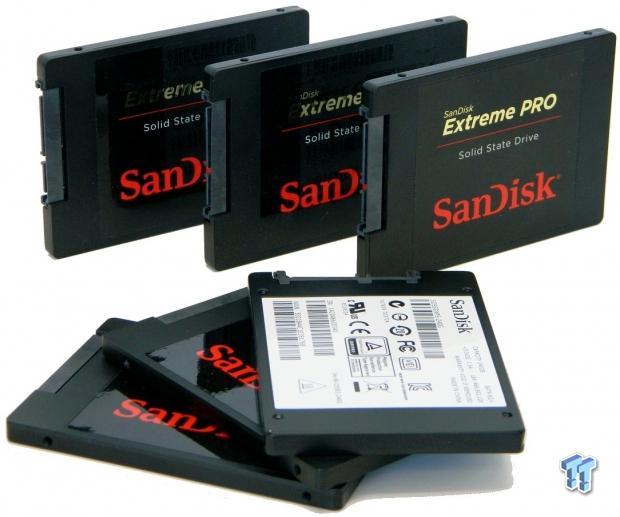
SanDisk's Extreme II series has been, and continues to be one of the best performing SSDs on the market. The Extreme II series is known for superior performance in a heavy usage environment. As a single drive, there is still nothing (other than the Extreme Pro) that can outperform the Extreme II if what you need is a SSD that provides consistent performance in extreme consumer based usage scenarios. The Extreme II series relies on emulated SLC layer caching technology called "nCache" to deliver superior performance and endurance.
SanDisk's new Extreme Pro series builds on the success of SanDisk's Extreme II series, coming mainly in the form of their second-generation nCache emulated SLC layer technology. SanDisk calls their second-generation caching technology nCache Pro. Originally, nCache technology primarily focused on increasing endurance by consolidating small random writes on the SLC programmed layer of the flash, and flushing those writes sequentially to the drive's MLC programmed flash array. This technique delivers superior endurance.
With nCache Pro technology, SanDisk has refocused SLC layer based caching technology to deliver class leading endurance, and increasing performance in a manner similar to what we have seen from Samsung's 840 EVO series. nCache Pro technology is a more refined balance between endurance and performance than we get from the original nCache technology. In addition to nCache Pro, SanDisk overclocks the flash processor, and over provisions the flash array for faster performance, and long-term endurance.
SanDisk has so much confidence in their nCache Pro technology and high-grade 1Ynm (A19, 19mm x 19.5mm) ABL MLC 64Gbit Toggle flash, that they now offer an industry leading ten-year warranty to back their flagship Extreme Pro SSDs. It is worth noting that the ten-year warranty is actually ten years, or 80 terabytes written, whichever comes first. Most of you will not hit 80 terabytes written over the lifetime of a ten-year warranty, so it should be good for ten years for the majority of users.
On the user management front, SanDisk now has a very clean and functional SSD toolbox called "SanDisk SSD Dashboard." This tool allows you to secure erase SanDisk SSDs and change partition sizes, and it includes many other useful tools for managing your SanDisk SSD.
Let's go ahead and get into this review. There are plenty of reviews that have documented the performance of a single SanDisk Extreme Pro, so we are not going to focus on comparing the performance of the Extreme Pro to other drives; we already know it is unbeatable as a single drive in a heavy duty usage scenario. What we are going to examine today is how well the SanDisk Extreme Pro scales in RAID 0 arrays. After all, the more the better, right? Let's find out!
PRICING: You can find SanDisk's Extreme Pro 240GB for sale below. The prices listed are valid at the time of writing, but can change at any time. Click the link to see the very latest pricing for the best deal.
United States: The SanDisk Extreme Pro 240GB retails for $129.99 at Amazon.
Canada: The SanDisk Extreme Pro 240GB retails for CDN$177.87 at Amazon Canada.
Specifications, Drive Details, Test System Setup, Drive Properties, Pricing, and Availability
Specifications
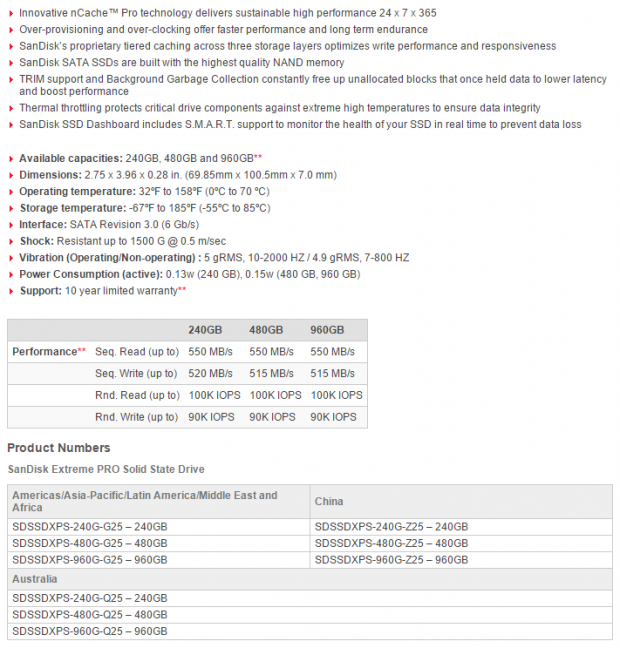
SanDisk's Extreme Pro series 2.5" SATA III SSD is available in three capacities, 240GB, 480GB, and 960GB. Specifications list the 7mm x 2.5"Extreme Pro SSDs as having a bandwidth performance of up to 550MB/s sequential read and 520MB/s sequential writes. 4KB random read performance is listed at up to 100,000 IOPS, and 4KB random write performance is listed at up to 90,000 IOPS.
When you purchase a retail packaged Extreme Pro SSD, you get the SSD and a 7mm to 9.5mm plastic spacer to better accommodate the drive in laptops that are designed for 9.5mm HDDs. As mentioned previously, SanDisk has their custom SSD dashboard for end-user management available through free download. SanDisk provides an industry leading ten-year limited warranty to back the Extreme Pro.
Because this is a RAID review, we are going to focus on performance rather than features. For a more in-depth look at the SanDisk Extreme Pro's feature set, I will refer you to Chris Ramseyer's extensive review of SanDisk's Extreme Pro 240GB SSD.
Drive Details - SanDisk Extreme Pro 240GB SSD

The top of the Extreme Pro's enclosure is formed from a single piece of black plastic. Centered on the top face of the drive is a black manufacturer's sticker with red, white, and gold lettering.
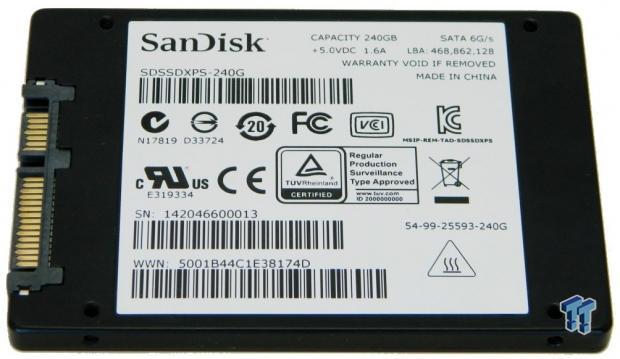
The bottom and sides of the Extreme Pro's enclosure is formed from a single piece of stamped aluminum that has been painted black. Centered on the rear face of the enclosure is a manufacturer's sticker that lists the drive's part number, serial number, capacity, and interface.

Here's what the SanDisk Extreme Pro 240GB SSD looks like completely disassembled. The Extreme Pro has a full-size PCB. The drive's controller, DRAM module, and NAND chips all make contact with a thermal pad, thereby dissipating heat generated into the aluminum half of the enclosure. The other side of the PCB is devoid of any major components.
Test System Setup

- Drive Properties

The majority of our testing is performed with our test drive/array as our boot volume. Our boot volume is 75% full for all OS Disk "C" drive testing to mimic a typical consumer OS volume implementation. We are using 64k stripes for our two to three drive arrays, and 32k stripes for our four to six drive arrays. Write caching is enabled, and Windows buffer flushing is disabled.
All of our testing includes charting the performance of a single drive, as well as RAID 0 arrays of our test subjects. We are utilizing Windows 8.1 64-bit for all of our testing. We will be posting screen shots of our six-drive array's benchmarks.
Synthetic Benchmarks - ATTO, Anvil Storage Utilities, CrystalDiskMark & AS SSD
ATTO
Version and / or Patch Used: 2.47
ATTO is a timeless benchmark used to provide manufacturers with data used for marketing storage products.

Sequential read transfers max out at 1.631 GB/s. Sequential write transfers max out at 1.298 GB/s. Sequential performance is, of course, limited by our chipset's bandwidth limitations. The maximum sequential read is the highest we've seen from any six-drive array to date.
Sequential Write

Sequential write transfers max out our Lynx Point Chipset with a three-drive array.
Sequential Read
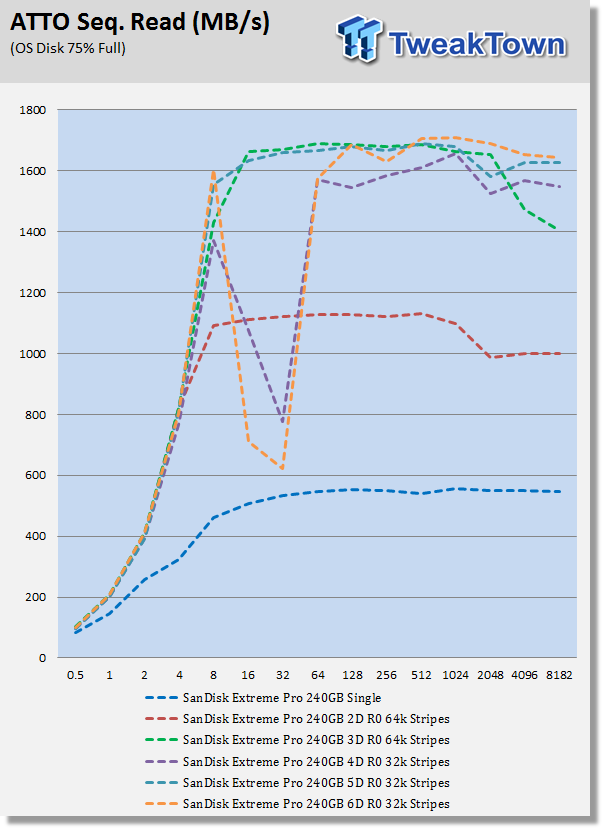
Sequential read transfers scale very well until we hit a three-drive array, where bandwidth limitations restrict sequential throughput. We do gain performance slightly as we go from a three-drive array to four, five, and six-drive arrays. This test was run with no wait time after filling our arrays to 75% of their capacity. We did not give our four and six-drive arrays time to settle in after filling, which is why we see a faux performance drop at 16 and 32k transfer sizes.
Anvil Storage Utilities
Version and / or Patch Used: 1.1.0
Anvil's Storage Utilities is a storage benchmark designed to measure the storage performance of SSDs. The Standard Storage Benchmark performs a series of tests; you can run a full test, or just the read or write test, or you can run a single test, i.e. 4k QD16.

Read scoring is very good. Write scoring is severely limited by operating system limitations at high queue depths. We see evidence of this by the drop in performance at high queue depths.
Read IOPS through Queue Depth Scale
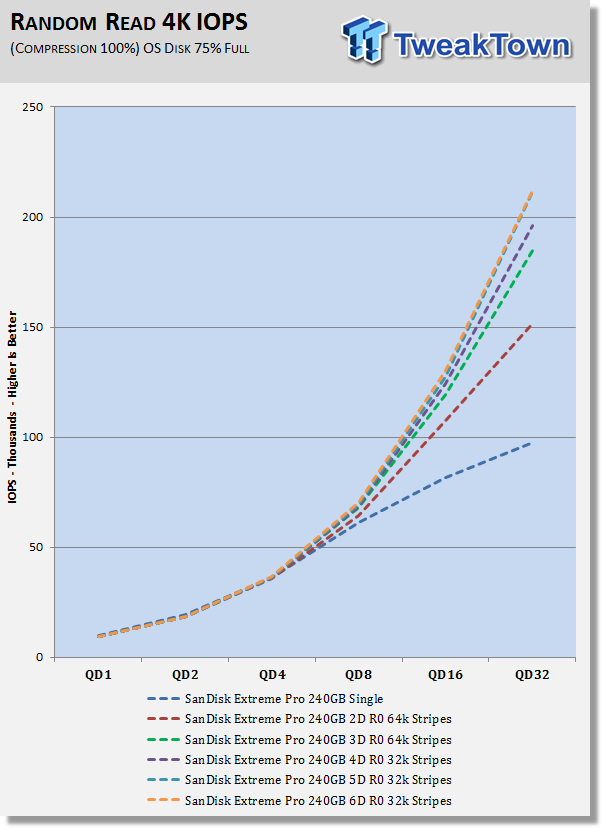
Read performance continues to increase as we add drives to our array, with peak performance coming at QD4.
Write IOPS through Queue Scale

Write performance does increase as we add drives to our array; however, Windows 8.1 restricts our array's IOPS from continuing to climb above QD4, and in fact causes write IOPS to fall and flatten out at QD8 - QD32. This is not the chipset, this is Windows 8.1 flushing policies.
CrystalDiskMark
Version and / or Patch Used: 3.0 Technical Preview
CrystalDiskMark is disk benchmark software that allows us to benchmark 4k and 4k queue depths with accuracy.
Note: Crystal Disk Mark 3.0 Technical Preview was used for these tests since it offers the ability to measure native command queuing at four and 32.

This is excellent random performance, even with Windows 8.1. This kind of random write performance is exactly why current PCIe drives are left in the dust by SATA based arrays in an OS environment.

Read performance continues to climb as we add drives to our array. The difference between a three-drive array and a six-drive array is bandwidth limited, yet we do see a pretty good increase in performance at 512k, and a very good increase as we hit 4k QD32 with our six-drive array.

Random 4k write performance is on an upward trend as we add drives to our array, with the best performance delivered at QD4.
AS SSD
Version and / or Patch Used: 1.7.4739.38088
AS SSD determines the performance of Solid-State Drives (SSD). The tool contains four synthetic, as well as three practice tests. The synthetic tests determine the sequential and random read and write performance of the SSD.


AS SSD reveals a nice, steady performance increase as we add drives to our array. With the last of our synthetic testing completed, let's move to our light usage model testing to give us a better idea of what's under the hood of our Extreme Pro arrays in an OS environment.
Benchmarks (Trace Based OS Volume) - PCMark Vantage, PCMark 7 & PCMark 8
Light Usage Model
We are going to categorize these tests as indicative of a light workload. If you utilize your computer for light workloads like browsing the web, checking emails, light gaming, and office related tasks, then this category of results is most relevant for your needs.
PCMark Vantage - Hard Disk Tests
Version and / or Patch Used: 1.2.0.0
The reason we like PCMark Vantage is because the recorded traces are played back without system stops. What we see is the raw performance of the drive. This allows us to see a marked difference between scoring that other trace-based benchmarks do not exhibit. An example of a marked difference in scoring on the same drive would be empty vs. filled vs. steady state.
We run Vantage three ways. The first run is with the OS drive/Array 75% full to simulate a lightly used OS volume filled with data to an amount we feel is common for most users. The second run is with the OS volume written into a "Steady State" utilizing SNIA's guidelines (Rev 1.1). Steady state testing simulates a drive/array's performance similar to that of a drive/array that has been subjected to consumer workloads for extensive amounts of time. The third run is a Vantage HDD test with the test drive/array attached as an empty, lightly used, secondary device.
OS Volume 75% Full - Lightly Used

OS Volume 75% Full - Steady State

Secondary Volume Empty - Lightly Used

As you can see, there's a big difference between an empty drive/array, one that's 75% full/used, and one that's in a steady state.
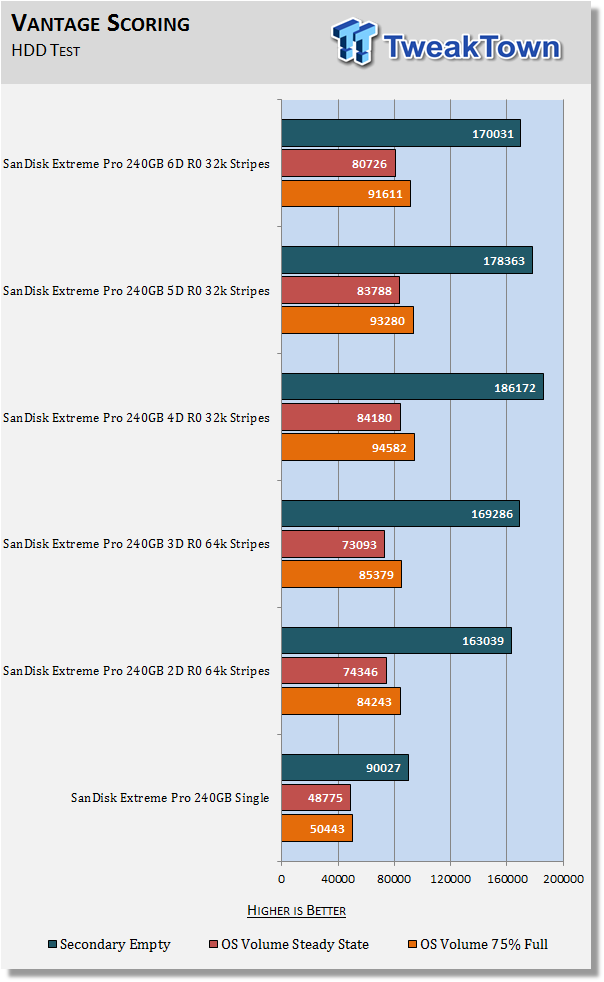
The important scores to pay attention to are "OS Volume Steady State" and "OS Volume 75% full." These two categories are most important because they are indicative of typical consumer user states.
When a drive/array is in a steady state, it means garbage collection is running at the same time it's reading/writing. This is exactly why we focus on steady state performance. This testing probably best illustrates why we switch to 32k stripes at four to six drive arrays. Our four-drive array is delivering the best all-around performance in this round of testing.
PCMark 7 - System Storage
Version and / or Patch Used: 1.4.00
We will look to the Raw System Storage scoring for RAID 0 evaluations because it's done without system stops, and therefore allows us to see significant scoring differences between drives/arrays.
OS Volume 75% Full - Lightly Used

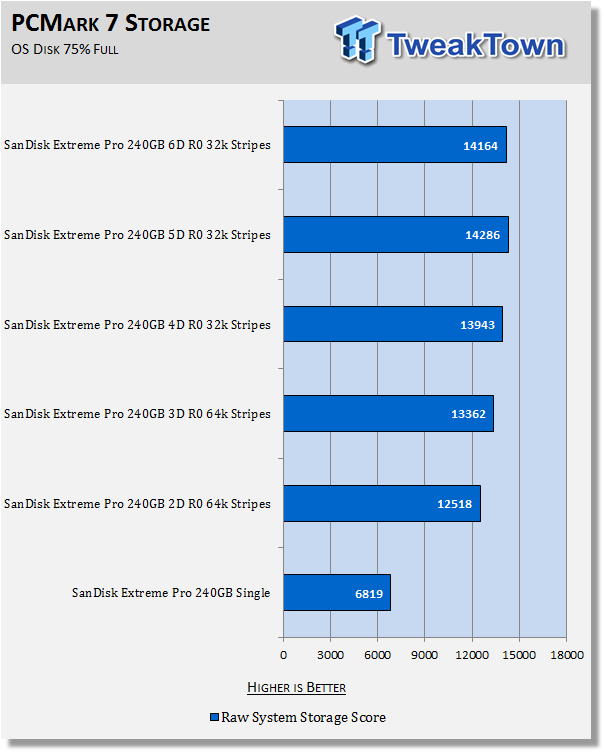
Stripe sizes play an important role in this scenario. If we stayed with 64k stripes, we would not get a performance increase from three to six drives. After much testing, we've determined that when exceeding three drives, 32k stripes deliver superior all-around array performance. Our five-drive array is delivering the best performance of the bunch in this test.
PCMark 8 - Storage Bandwidth
Version and / or Patch Used: 1.2.157
We use the PCMark 8 Storage benchmark to test the performance of SSDs, HDDs, and hybrid drives with traces recorded from Adobe Creative Suite, Microsoft Office, and a selection of popular games. You can test the system drive, or any other recognized storage device, including local external drives. Unlike synthetic storage tests, the PCMark 8 Storage benchmark highlights real-world performance differences between storage devices.
OS Volume 75% Full - Lightly Used

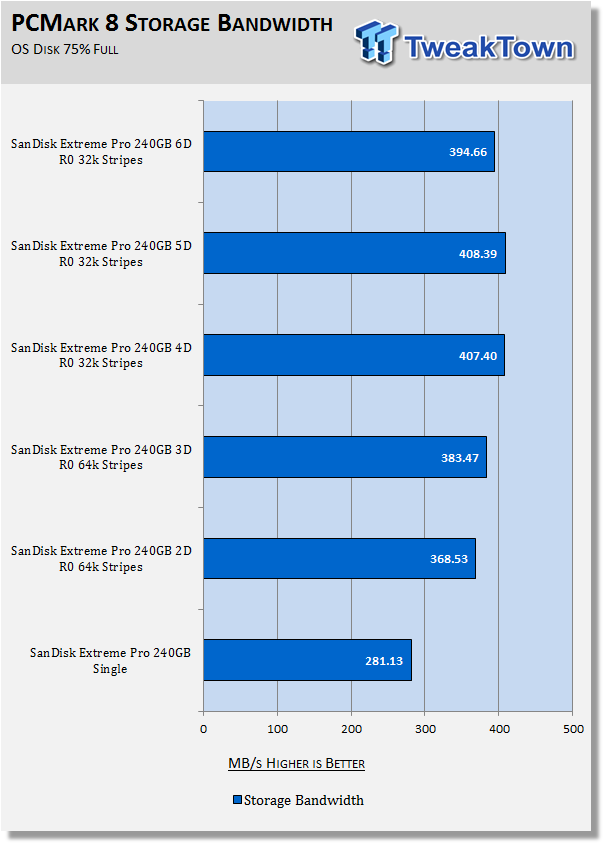
Our Extreme Pro arrays don't scale after four drives. This is typically what we see from consumer based SSDs. Drives like the Intel 730 that have enterprise DNA do much better; in fact, our six-drive Intel 730 480GB array is able to hit a whopping 524 MB/s storage bandwidth in this test, so it looks like we will not have a new RAID champion for a while. It is important to note that the Intel 730 is a more expensive drive that is designed specifically for RAID applications.
Benchmarks (Secondary Volume) - Disk Response & Transfer Rates
Iometer - Disk Response
Version and / or Patch Used: 1.1.0
We use Iometer to measure disk response times. Disk response times are measured at an industry accepted standard of 4k QD1 for both write and read. Each test is run twice for 30 seconds consecutively, with a five-second ramp-up before each test. The drive/array is partitioned and attached as a secondary device for this testing.
Write Response

Read Response

Average Disk Response

Write response times benefit most from RAID 0 because of write caching. There is a slight latency increase in read response times for an array vs. a single drive.
DiskBench - Directory Copy
Version and / or Patch Used: 2.6.2.0
We use DiskBench to time a 28.6GB block (9,882 files in 1,247 folders) of mostly incompressible random data as it's transferred from our Intel P3700 PCIe SSD to our test drive/array. We then read from a 6GB zip file that's part of our 28.6GB data block to determine the test drive/array's read transfer rate. The system is restarted prior to the read test to clear any cached data, ensuring an accurate test result.
Write Transfer Rate

Read Transfer Rate

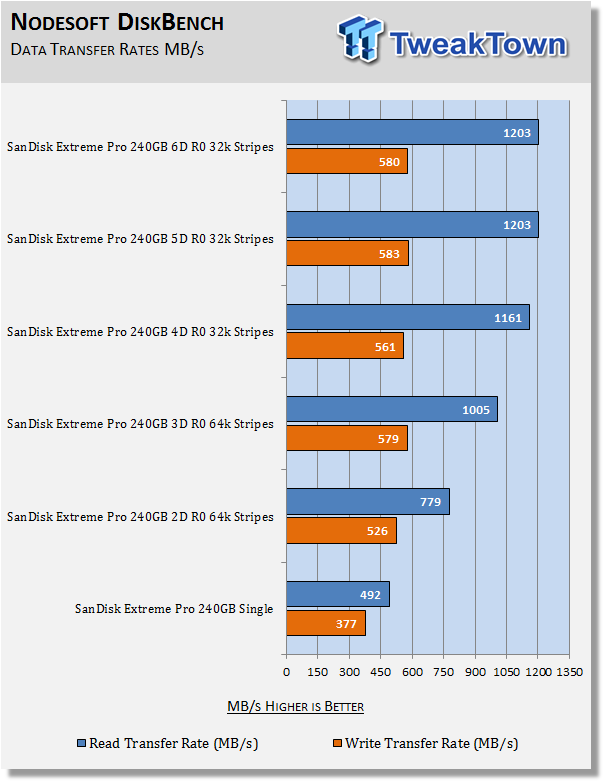
Now that we have an Intel P3700 at our disposal, we can chart up to a six-drive array's transfer rates. We are still limited by single lane signaling of the SATA interface though. Furthermore, the data we are transferring is not sequential in nature. The 580 MB/s write transfer rate is getting close to the limits of what our SATA interface will allow, as evidenced by the fact that we can hit this transfer rate with a three-drive array. Read transfers are a different matter though, and we see a nice increase in rates up to a five-drive array.
Benchmarks (Secondary Volume) - PCMark 8 Extended
Futuremark PCMark 8 Extended - Consistency Test
Heavy Usage Model
We consider PCMark 8's consistency test to be our heavy usage model test. This is the usage model most enthusiasts, heavy duty gamers, and professionals fall into. If you do a lot of gaming, audio/video processing, rendering, or have workloads of this nature, then this test will be most relevant to you.
PCMark 8 has built-in, command line executed storage testing. The PCMark 8 Consistency test measures the performance consistency, and the degradation tendency of a storage system.
The Storage test workloads are repeated. Between each repetition, the storage system is bombarded with a usage that causes degraded drive performance. In the first part of the test, the cycle continues until a steady degraded level of performance has been reached. (Steady State)
In the second part, the recovery of the system is tested by allowing the system to idle and measuring the performance with long intervals. (TRIM)
The test reports the performance level at the start, the degraded steady state, and the recovered state, as well as the number of iterations required to reach the degraded state and the recovered state.
We feel Futuremark's Consistency Test is the best test ever devised to show the true performance of solid state storage in a heavy usage scenario. This test takes an average of 13 to 17 hours to complete, and writes somewhere between 450GB and 14,000GB of test data, depending on the drive(s) being tested. If you want to know what a SSD's performance is going to look like after a few months or years of heavy usage, this test will show you.
Here's a breakdown of Futuremark's Consistency Test:
Precondition phase:
1. Write to the drive sequentially through up to the reported capacity with random data.
2. Write the drive through a second time (to take care of overprovisioning).
Degradation phase:
1. Run writes of random size between 8*512 and 2048*512 bytes on random offsets for ten minutes.
2. Run performance test (one pass only).
3. Repeat one and two, eight times, and on each pass increase the duration of random writes by five minutes.
Steady state phase:
1. Run writes of random size between 8*512 and 2048*512 bytes on random offsets for 50 minutes.
2. Run performance test (one pass only).
3. Repeat one and two, five times.
Recovery phase:
1. Idle for five minutes.
2. Run performance test (one pass only).
3. Repeat one and two, five times.
Storage Bandwidth
PCMark 8's Consistency test provides a ton of data output that we can use to judge a drive/array's performance.

We consider steady state bandwidth (the blue bar) our test that carries the most weight in ranking a drive/array's performance. The reason we consider steady state performance more important than TRIM is that when you are running a heavy-duty workload, TRIM will not be occurring while that workload is being executed. TRIM performance (the orange and red bars) is what we consider the second most important consideration when ranking a drive/array's performance. Trace based consistency testing is where truly high performing SSDs are separated from the rest of the pack.
The Extreme Pro hits peak performance at a four-drive array. In that respect, the Extreme Pro is quite a good performer in RAID 0, as most arrays tend to top out at three drives. While this is a good performance, it's not enough to unseat our current RAID 0 Champion, Intel's 730 480GB, which delivers a 388MB/s steady state performance with a three-drive array, and 426Mb/s with a six-drive array.

We chart our test subject's storage bandwidth as reported at each of the test's 18 trace iterations. This gives us a good visual perspective of how our test subjects perform as testing progresses.
Total Access Time (Latency)
Access time is the time delay or latency between a request to an electronic system, and the access completion, or the requested data returned. Access time is how long it takes to get data back from the disk. We chart the total time the disk is accessed as reported at each of the test's 18 trace iterations.

This is a great visual representation of what RAID 0 brings to the table. Look at how much lower latency is for a two-drive array in comparison to a single drive; it's three times lower. This is a powerful illustration of why you need to be running RAID 0 if you want the best performance from your enthusiast class PC.
Disk Busy Time
Disk Busy Time is how long the disk is busy working. We chart the total time the disk is working as reported at each of the test's 18 trace iterations.

When latency is low, disk busy time is low as well. In a steady state, an Extreme Pro array is about 2.5 times more efficient than a single drive with the exact same workload. It is worth noting that 2.5 times less disk busy time is a nice increase in performance, but it's also a testament to just how well a single Extreme Pro performs. This is because most SSDs see around a seven to tenfold decrease in disk busy time from a single drive to an array. It's easy to see why the Extreme Pro is currently our steady state performance champion when it comes to a single drive in an OS environment.
Data Written
We measure the total amount of random data that the drive/arrays are capable of writing during the degradation phases of the consistency test. The total combined time that degradation data is written to the drive/arrays is 470 minutes. This can be very telling. The better the drive/array can process a continuous stream of random data, the more data will be written.
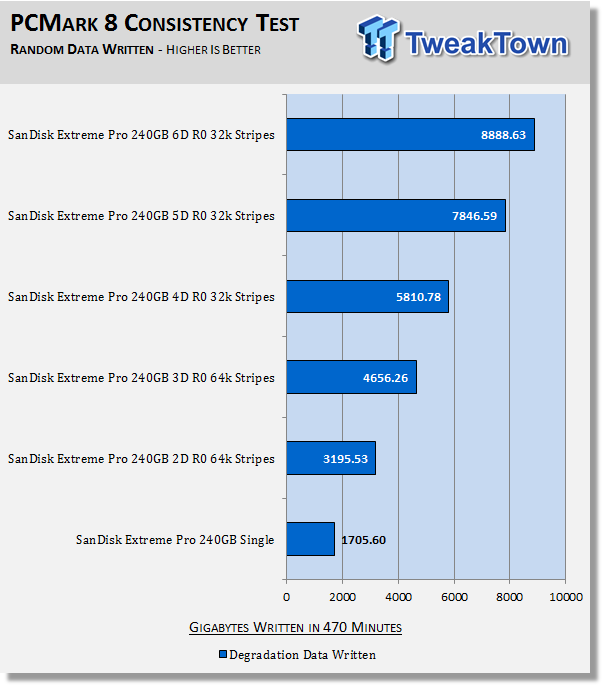
This data shows an aspect of performance that typical benchmarks simply cannot. Even though we are handicapped by our Lynx Point chipset's limited sequential bandwidth, we observe perfect scaling from one to six drives, culminating in our six-drive array delivering an impressive 8,800 gigabytes of random data written in 470 minutes.
Final Thoughts
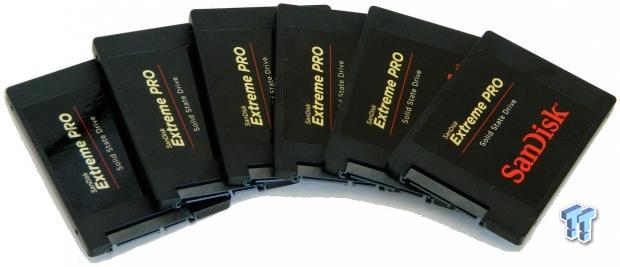
Solid state storage is the most important performance component found in a modern system today; without it, you do not even have a performance system.
SanDisk's Extreme Pro represents the full exploitation of planar NAND consumer based technology. SanDisk's nCache Pro technology is innovative and delivers astounding performance that only gets better in RAID 0.
We don't have enough Toshiba Q series Pro's to do a direct comparison of four to six-drive arrays to declare with absolute certainty that the Extreme Pro the fastest RAID 0 option available with 1Ynm (A19, 19mm x 19.5mm) ABL MLC Toggle flash, but more than likely, that is the case.
RAID 0 introduces different performance dynamics, and the drive that performs best is not always the drive that performs best in RAID 0 where the ultimate in enthusiast class performance is delivered. As we have been stressing, the true performance of a SSD or multiple SSDs in RAID cannot be measured in a FOB state, and has very little to do with published sequential performance numbers touted by a drive's manufacturer.
Steady state performance is the true measure of any SSD's performance because a steady state is eventually where every flash-based storage device is going to settle into and remain, so how a drive/array performs in a steady state is the single most important bit of information you need to know when choosing your next SSD. When it comes to this important metric, SanDisk's Extreme Pro delivers the goods nicely.
An industry leading ten-year warranty, awesome steady state performance while performing heavy-duty workloads, a great toolbox, pricing, and the SanDisk name, are all reasons why SanDisk's Extreme Pro is a drive/array that I highly recommend you own. Buy some, and you will be glad you did.
RAIDing two or more drives together provides you with storage that takes performance to the next level, and is something I recommend you try. Think of it as the SLI of storage. Once you go RAID, there's no going back!
PRICING: You can find SanDisk's Extreme Pro 240GB for sale below. The prices listed are valid at the time of writing, but can change at any time. Click the link to see the very latest pricing for the best deal.
United States: The SanDisk Extreme Pro 240GB retails for $129.99 at Amazon.
Canada: The SanDisk Extreme Pro 240GB retails for CDN$177.87 at Amazon Canada.


 United
States: Find other tech and computer products like this
over at
United
States: Find other tech and computer products like this
over at  United
Kingdom: Find other tech and computer products like this
over at
United
Kingdom: Find other tech and computer products like this
over at  Australia:
Find other tech and computer products like this over at
Australia:
Find other tech and computer products like this over at  Canada:
Find other tech and computer products like this over at
Canada:
Find other tech and computer products like this over at  Deutschland:
Finde andere Technik- und Computerprodukte wie dieses auf
Deutschland:
Finde andere Technik- und Computerprodukte wie dieses auf